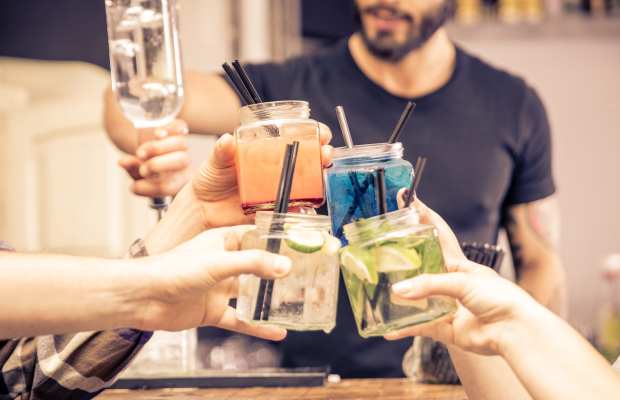Reimagining The Bar Experience Without The Booze

When the ball drops and Americans ring in the New Year in a little under two weeks there are some things we can collectively count on happening: “Auld Lang Syne” will play, people will cheer and kisses will be exchanged. But what fewer people will be doing, statistically speaking, is reaching for a glass of champagne to ring in the new year because Americans have been steadily drinking less for the last few years. In 2019 alcohol consumption in the U.S. fell by just shy of 1 percent, more than the 0.8 percent it declined in 2018 and the 0.7 percent it fell in 2017 according to IWSR, an industry tracker for the drinks market.
Most of the losses have been to beer, where sales have fallen by nearly 2.5 percent in that last three years — though wine has also taken a hit with a 0.4 percent loss in sales. It is not quite fair to say that America has become a nation of teetotalers or is even well on their way to becoming one. White Claw was the fad drink of the summer and did $1.2 billion in sales between October 2018 and October 2019 — a roughly 200 percent jump — and kicked off something of a spiked seltzer follow-on craze. Both Anheuser Busch and Boston Beer Company (better known as Sam Adams) have released their own versions of spiked seltzer. And while wine in a bottle is seeing sales declines, wine in a can is enjoying a bumper sales year in the U.S. According to Nielsen, wine in a can sales were up 73 percent between October 2018 and October 2019, totaling $54 million.
But even if Americans are not quite forswearing their drinking ways entirely, the emerging conventional wisdom is that Americans, particularly millennials and Gen Z (the oldest members of which are now 23 and legally old enough to drink), are drinking differently than they ever had. Driven by the ever-expanding wellness movement, younger consumers are reportedly looking to do it differently than their forebears. Young people aren’t getting sober, per se, noted an often-cited Atlantic article from earlier this year, but they are getting decidedly “soberish.”
“There does come a time when there has to be some introspection,” Britta Starke, an addictions therapist and the program director of the Alcohol and Substance Abuse Center at the University of North Carolina told the Atlantic. “Folks in the Millennial generation have maybe a better sense of balance. Some do yoga or meditation or are physically active, so they don’t need to find stimulation and stress reduction in substances.”
The gradual shift away from drinking as a central social activity has also created an entrepreneurial opportunity for innovators looking to fill a vacancy. GrubStreet writer Gabriella Paiella noted that she didn’t miss drinking that much three years after giving it up. Mostly she found it was an unquestionable benefit in her life. But she did miss going to bars — something she rapidly learned was no longer fun for her once she had quite alcohol, mostly because bars aren’t built to be accommodating to non-drinkers, with basically two offerings for them: water or club soda.
“These are not drinks you nurse at the same pace as your imbibing friends; they are drinks you suck down in two minutes. They’re drinks that say, You should be drinking me out of a pitcher at Chuck E. Cheese,” Paiella said.
And while we suspect she has never been to a Chuck E. Cheese, as she would know one would be hard-pressed to come across a pitcher of club soda there, her point has sparked an innovative movement that has spent much of 2019 gaining speed across the U.S. — keep the concept of the bar, but ditch the booze.
The Getaway, located in Brooklyn’s ultra-trendy Greenpoint neighborhood, opened earlier this year to surf the emerging trend. It was founded and is run by Sam Thonis and Regina Dellea, two media industry alumni who walked away from corporate America to launch an alcohol-free bar to capture what they believe is an emerging demographic of soberish consumers.
A fun activity, he noted, that doesn’t necessarily rely on consuming alcohol. What people in a bar are often looking for isn’t a place to get drunk, but a place for fun and fellowship. And the Getaway provides that, with a muted cool color palette and rounded-edge, mid-century modern understated chic aesthetic many patrons describe as Instagram-ready.
As are the drinks — brightly colored mocktails like Ginger Spice (spicy ginger, cucumber, grapefruit juice, extra-bitter tonic, club soda and blackberries), Lone Wolf and Shrub (rhubarb shrub, lime juice, elderflower syrup and basil), The Coconaut (pineapple, coconut milk, cream of coconut, blood-orange flavored Pellegrino and nutmeg) and Daters Gonna Date (Medjool dates, peanut butter, lime-banana syrup, vanilla, macadamia-nut milk and Coco Rico soda).
The Getaway is not unique — New York in 2019 saw over a dozen alcohol- free bars open their doors and it remains to be seen if the local bump in sobriety in younger consumers is the mark of a real sea change in consumer habits or just a blip. If it is more the former, spaces that eschew alcohol will do well in providing an alcohol-free bar experience. If not? Well, if millennials and Gen Zs rediscover a passion for hard drinking in 2020, we suspect some of those alcohol-free bars might change up their lineups a bit to include harder spirits than fig juice.
